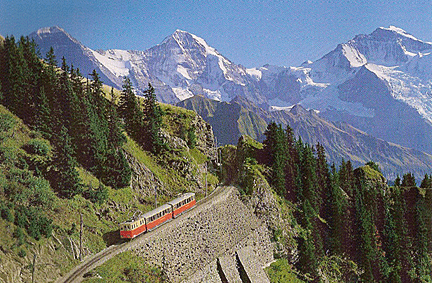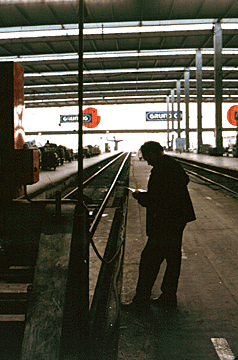 A woman couldn't find the ticket she just purchased
for Luzerne, when the train conductor came around. "I have it
right here, Madam," he said politely, pulling the cardboard slip
from his pocket. She'd apparently left it at the ticket window, and
the ticket clerk had sent it up to the conductor of the Luzerne train. A woman couldn't find the ticket she just purchased
for Luzerne, when the train conductor came around. "I have it
right here, Madam," he said politely, pulling the cardboard slip
from his pocket. She'd apparently left it at the ticket window, and
the ticket clerk had sent it up to the conductor of the Luzerne train.
"Only in Switzerland!" she exclaimed. Her
remark applies to many other aspects of the Swiss transportation
system as well.
Efficiency, variety, and convenience characterize
the integrated network of train, boats, buses, mountain railways, and
aerial cable cars in this tiny country. Combined with a wealth of
descriptive literature, this system helps to make Switzerland an easy
place to visit. Getting around is part of the fun.
Traveling around Switzerland is almost like
traveling on a life-size model railroad. It's almost as if one person
is at the controls. Departures are punctual, and the synchronization
of timetables among the various forms of transport is astounding.
 The Official Timetable exemplifies the Swiss
attention to detail and will be rewarding to you if you like planning
your own itinerary. Available for about $5 in all train stations, it
includes altitudes, distances, and much useful information in English
and other languages. The Official Timetable exemplifies the Swiss
attention to detail and will be rewarding to you if you like planning
your own itinerary. Available for about $5 in all train stations, it
includes altitudes, distances, and much useful information in English
and other languages.
If you're traveling from Switzerland to another
country, a night train may be your best bet. You'll not only save on
hotel expenses but you'll find it a good way to meet people. Unless
you have a regular (non-student) Eurail Pass which provides
first-class accommodations and, often, room to stretch out on your
seat, you may want to reserve a bed in a couchette.
The couchette car has four to six bunks to a
compartment in first or second class. As only the wagonlits (or
sleeping cars), which add two-thirds to the cost, provide complete
privacy, there's no distinct advantage to first class. In either case,
you're bound to learn what life is like in a submarine.
Regardless, be aware of a few tips on couchette
etiquette. Liquids consumed on upper bunks can be dangerous in a
sudden stop, especially to your lower neighbor. Dangling feet can also
produce international confrontations. If you're prone to using the
bathroom in the middle of the night, try not to drink anything before
you go to bed, as getting in and out of the bunks can be difficult.
The major Swiss rail lines are complemented by
branching smaller ones. One such train leaves Lucerne and travels to
Engelberg, one of Switzerland's prime ski resorts. Another leaves Nyon,
just outside Geneva, for a winding climb into the Jura Mountains. This
antique narrow-gauge train has a special car for skis and for carrying
old-fashioned milk cans down from mountain pastures, as well.
You'll find that a trip on either train is truly a
trip into the past, as both feature red wooden cars, with warm yellow
wood interiors. Both creak comfortably as you climb the quiet
mountainsides.
Another good way to explore the heights is by car postaux
or postal
bus, which carries the mail but
also carry passengers, also. These buses cover 4,700 miles in a country twice the
size of New Jersey. They’re known for their reliability which is
nice to remember on the perilous route over the St. Bernard Pass. The
Swiss Railroad Authority authorizes its drivers to give orders, when
appropriate, to drivers of other vehicles on the road. The postal
buses, which announce themselves by sounding the first three notes of
the "William Tell Overture," offer access to the more remote
parts of Switzerland.
In addition, the postal system offers pamphlets
detailing walking and skiing tours that correspond to their routes.
While you can find the bus schedule listed in the official timetable,
further information is available at major post offices.
Some of the most remote locations in Switzerland can
be reached, even by residents, only by funicular, which is a grounded
cable car, or by telepherique, an aerial type. If you've
planned a long walk and it begins to rain, you may find a pleasant
temporary shelter in a private automatic funicular like the one which
climbs the hill above Montreux.
From June through September, steamers cross
Switzerland's many lakes, offering you a change of pace. The five-hour
trip from St. Gingolph to Geneva includes a close-up of the Chillon
Castle, distant views of changing mountain ranges and miles of
vineyards and chateaux. If you happen to be out when a storm comes up,
you can switch to a train at the next docking, using the same ticket.
As a tourist, you can take advantage of a number of
special tickets. The Swiss Holiday Card, designed for periods of 8,
15, or 30 days, covers all travel by rail, steamer, and postal bus,
and provides discounts for the mountain railroads and serial cable
cars. A Half-Fare Travel Card and a Senior Citizen Half-Fare are also
available. You’ll need to obtain all of these cards, as well as the
Eurail Pass, before your arrival in Switzerland, through a travel
agency or Swiss Air.
Transportation facilities within Swiss cities are
typically well-documented and simple to use. They're worth getting to
know, as taxis are expensive. Banks publish and freely distribute maps
which commonly include the bus routes.
Most bus stops provide a lighted map and a schedule.
A bus ticket, valid for an unlimited number of trips in an hour, can
be obtained from machines at each stop. You must hold your ticket
throughout your ride, in case one of the rare roving ticket-checkers
happens to hop on your bus. The Swiss citizens show a remarkable
discipline in this system, under which a frequent rider might be asked
to show his ticket only once in a nine-month period!
If you enjoy bicycling, you can rent a bicycle by
the hour at many railroad stations. They’ll also hold your luggage
while you're gone.
Regardless of which method of travel you choose in
Switzerland, you can hardly go wrong. If you arrive at the train
platform 30 seconds late to find you've missed your train, you needn't
despair. Just take the next train to anywhere in the country and
you'll be sure to connect to your original destination.
For more information, visit the Swiss National
Tourist Office. < Back to
Travel Articles
Go to the next travel article > |
